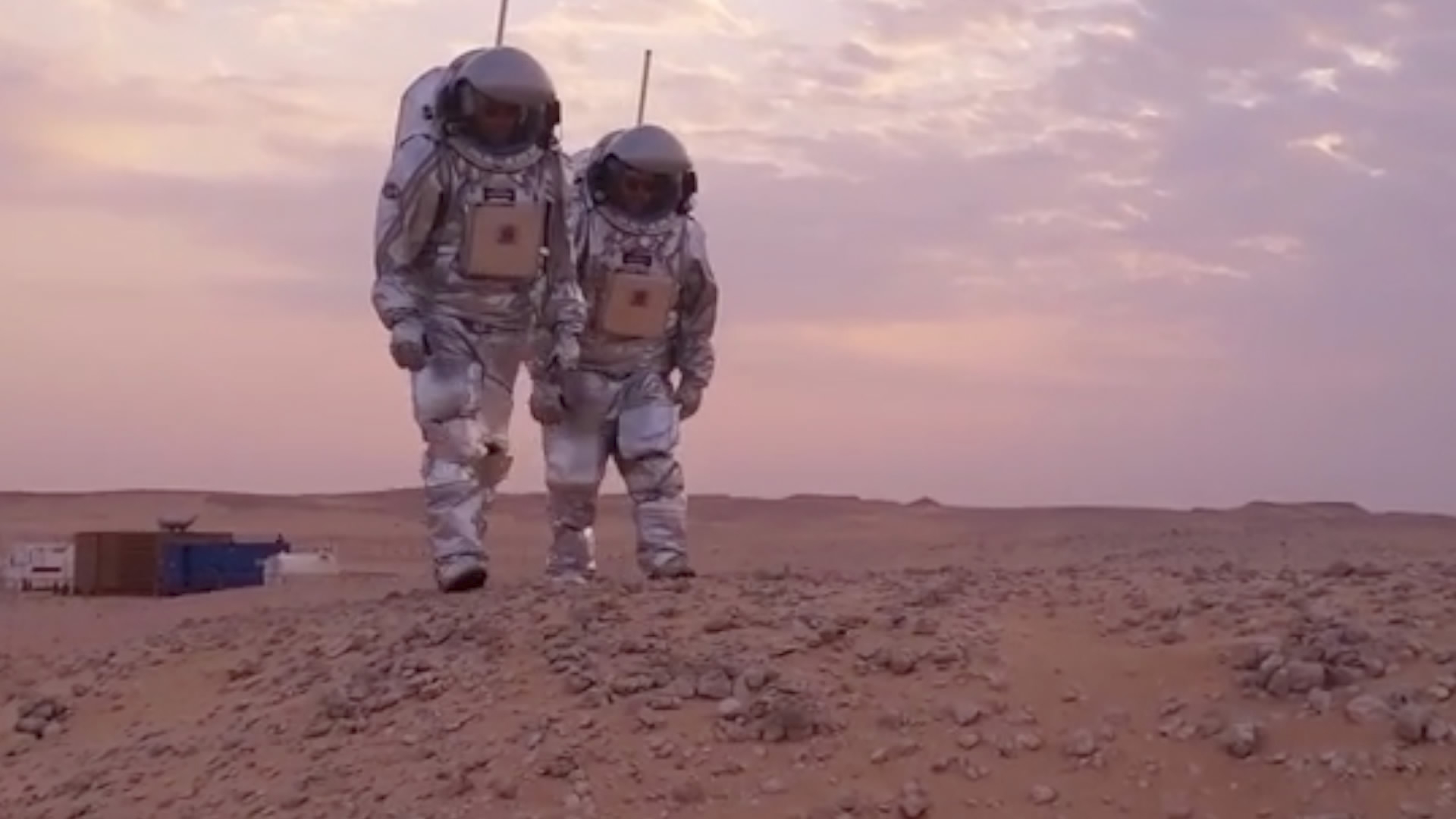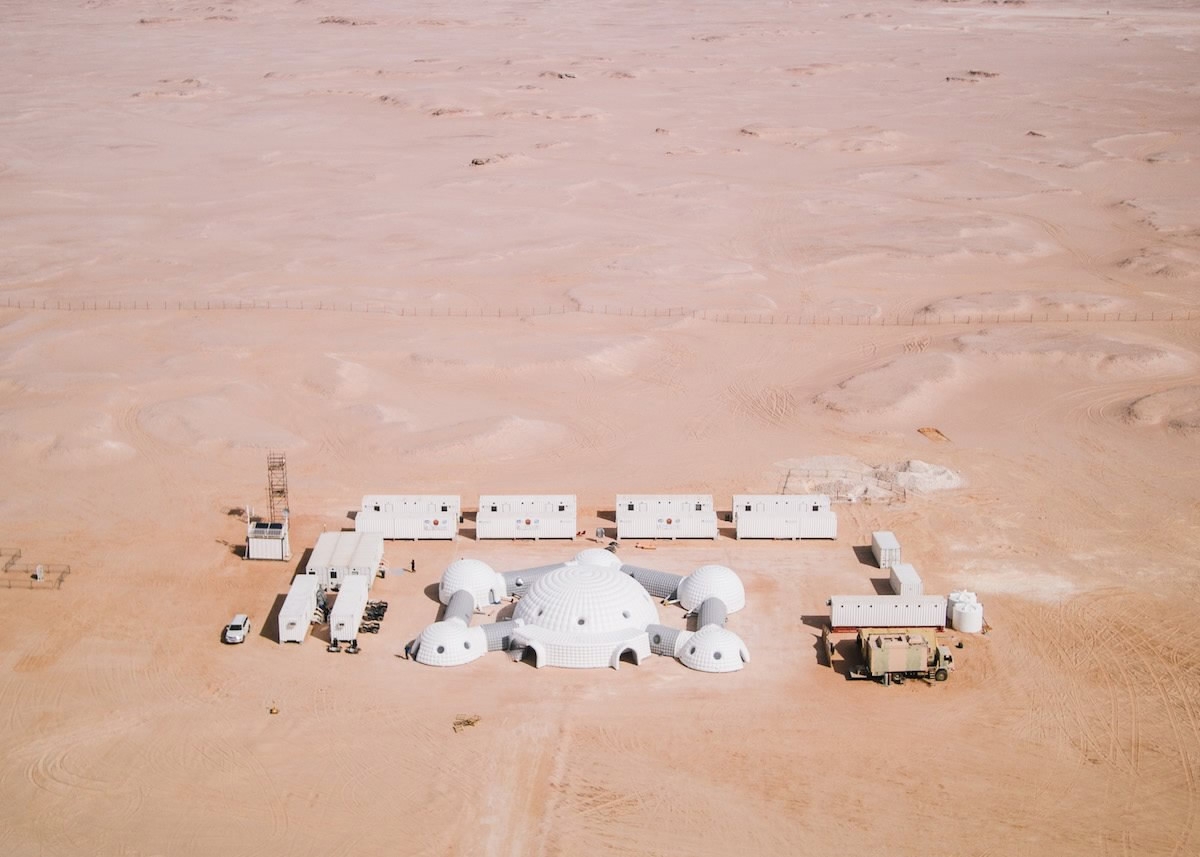
World
18:42, 07-Feb-2018
Oman Mars simulation follows SpaceX in pursuit of the Red Planet
By Abhishek G Bhaya

On a day SpaceX launched the “Falcon Heavy” rocket carrying Elon Musk’s Tesla Roadster towards an orbit beyond Mars, a striking video showed two astronauts in heavy spacesuits taking gradual steps on the rocky and crimson terrain of what appeared to be the surface of the Red Planet.
The visuals were realistic enough to make one wonder if humans have already landed on Mars. Not entirely off the mark. The setting for the video is indeed one of the first steps towards preparing mankind for the ambitious giant leap towards the fourth planet from the Sun.

A view of the desolate base camp in Rub' al Khali desert in Oman's Dhofar region in the backdrop of a setting Sun. /Photo via OeWF
A view of the desolate base camp in Rub' al Khali desert in Oman's Dhofar region in the backdrop of a setting Sun. /Photo via OeWF
The location is in fact a site in the Rub' al Khali (literally the Empty Quarter) desert of Oman where six analog astronauts are set to make a "landing" on Thursday for the month-long simulation mission titled AMADEE-18 and spend the next three weeks in Mars-like conditions.
The remote Omani desert, chosen precisely for its uncanny resemblance to Mars, will serve as the base camp during the mission conducted by the Austrian Space Forum, or OeWF (ÖsterreichischesWeltraum Forum).
The extreme seclusion of the site, which has reportedly little cell phone coverage, has warranted heavy security with soldiers with armored vehicles from the Royal Army of Oman guarding the make-shift Mars base camp. Fighters from the Royal Air Force of Oman’s nearest base in Thumrait, some 175 km from the mission site, have been kept in alert mode for emergency airlift if needed.

The Austrian Space Forum (OeWF) congratulated SpaceX for launching the "Falcon Heavy" rocket.
The Austrian Space Forum (OeWF) congratulated SpaceX for launching the "Falcon Heavy" rocket.
The OeWF, in a Twitter message on Wednesday, congratulated the US private rocket firm SpaceX for taking “a step closer to the first human walking on Mars”, a goal that defines the forum’s ongoing mission in Oman. “Together we get closer to Mars,” it added.
Crew meets visitors
The OeWF’s analog astronauts along with the field crew have spent the preparation week in Oman trying out and testing the equipment and carrying out other drills ahead of the “Landing Day” on Feb. 8, which marks the beginning of the Mars simulation phase.
The last few days before the “landing” were considered as a bridgehead phase, in which visitors were allowed inside the camp and interact with the astronauts for the last time before they enter their isolation. On February 2, a group from the Omani Astronomical Society, which is a key partner in the mission, visited the camp.
Local Omani women got a demonstration from analog astronaut Carmen Koehler on the workings of OeWF-designed Aouda spacesuit simulator. The field testing of these spacesuits, one of the first prototypes being developed for future Mars missions, is one of the key experiments for AMADEE-18.

Analog astronaut Carment Koehler (center) demonstrates the OeWF-designed Aouda space simulator to local visitors from Oman. /Photo via OeWF
Analog astronaut Carment Koehler (center) demonstrates the OeWF-designed Aouda space simulator to local visitors from Oman. /Photo via OeWF
“We planned this 12th analog mission for over one and a half years and finally being here at this magnificent desolation makes us proud,” Dr Gernot Grömer, OeWF president and the field commander for AMADEE-18 mission said in a statement.
“The landing day is approaching quickly for AMADEE-18 and our base station is shaping up nicely,” added Joao Lousada, deputy field commander.
Raising technological readiness
The field crew in “Mars” (Oman) was woken up on Wednesday by the “Earth” mission support center at the OeWF’s headquarters in Innsbruck, Austria by “Vienna calling”, a foot-tapping musical composition by Austrian legend Johann Hölzl, better known as Falco, whose 21st death anniversary was observed on Tuesday.
The title of the song was symbolic as later on Wednesday, the OeWF announced that the AMADEE18 crew participated through teleconferencing in the 55th Session of the UN COPUOS Scientific & Technical Subcommittee at the UN office in Vienna on Tuesday.

An aerial view of the desolate base camp in Rub' al Khali desert in Oman's Dhofar region. /Photo via OeWF
An aerial view of the desolate base camp in Rub' al Khali desert in Oman's Dhofar region. /Photo via OeWF
While the base camp at Oman is thoroughly isolated with little cell phone coverage, the field crew is connected to the outside world through short-wave radios, with a high-speed Internet connection linking them to Innsbruck.
However, there will be a delay of 10 minutes in communication between the mission support center and base camp, mimicking the time-lag in signals between both the planets.
An additional team in Canada will be monitoring the crew and receiving feedback from them, while a team of three doctors, who also double up as researchers, will be at the base camp, ready to spring into action in case of an emergency.
During the simulation phase, researchers will conduct nearly 20 experiments during AMADEE-18 exercise in their quest for life on the Red Planet. These would include simulations of the new Aouda spacesuit, testing a range of Mars rovers, new water detection systems and even a new portable greenhouse to grow food in space.
The experiments are broadly divided into categories of engineering, planetary surface operations, astrobiology, geophysics/geology, life sciences, virtual reality and other human factors.
The ability of the analog astronauts, rovers and robots in collecting samples, their maneuverability on the “Martian” terrain and their efficiency in transmitting the collected information to the mission support center will be crucial aspects of these experiments.
A positive outcome could substantially raise the level of technological readiness and developing systems that support the lives of astronauts in future Mars missions.
6269km

SITEMAP
Copyright © 2018 CGTN. Beijing ICP prepared NO.16065310-3
Copyright © 2018 CGTN. Beijing ICP prepared NO.16065310-3